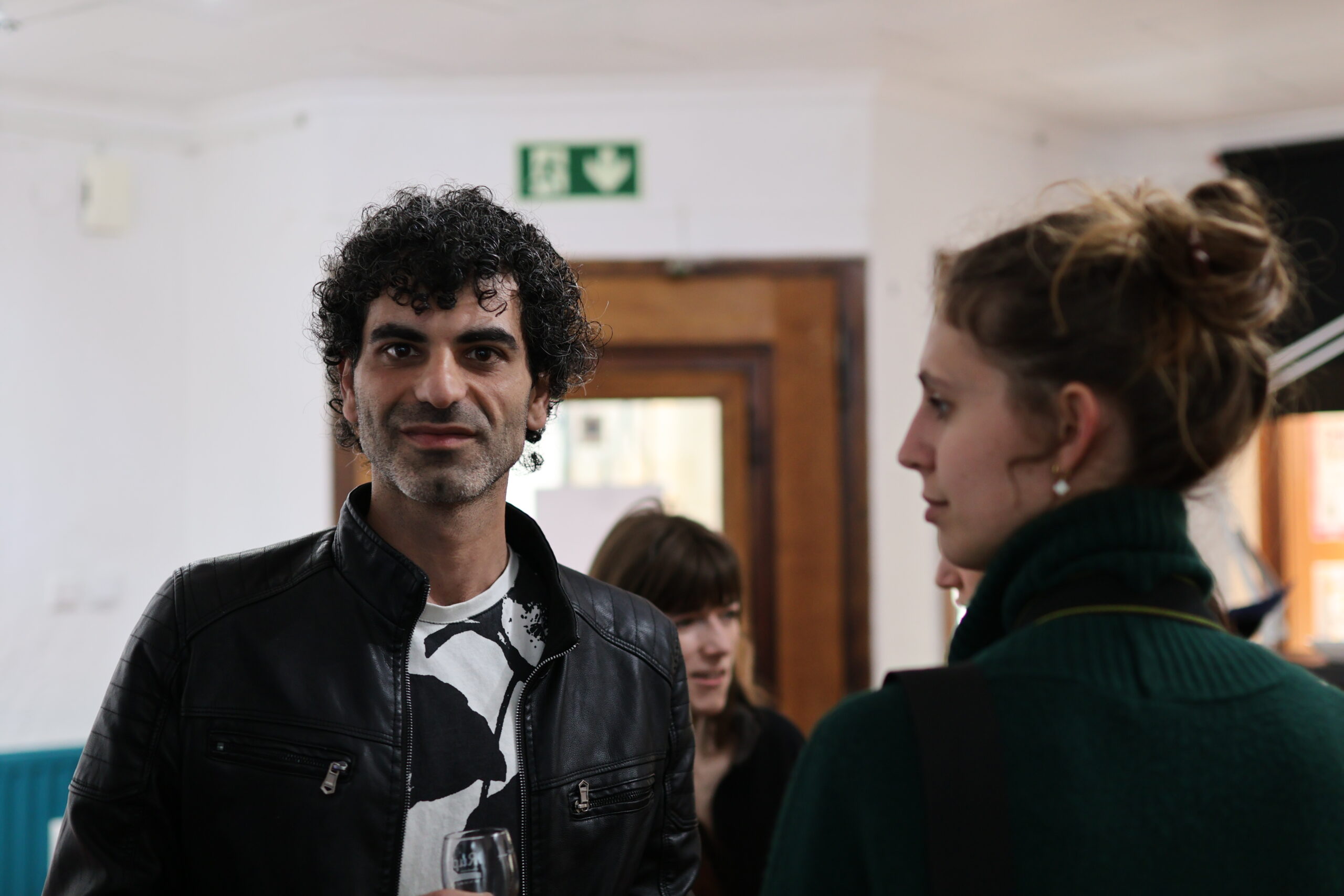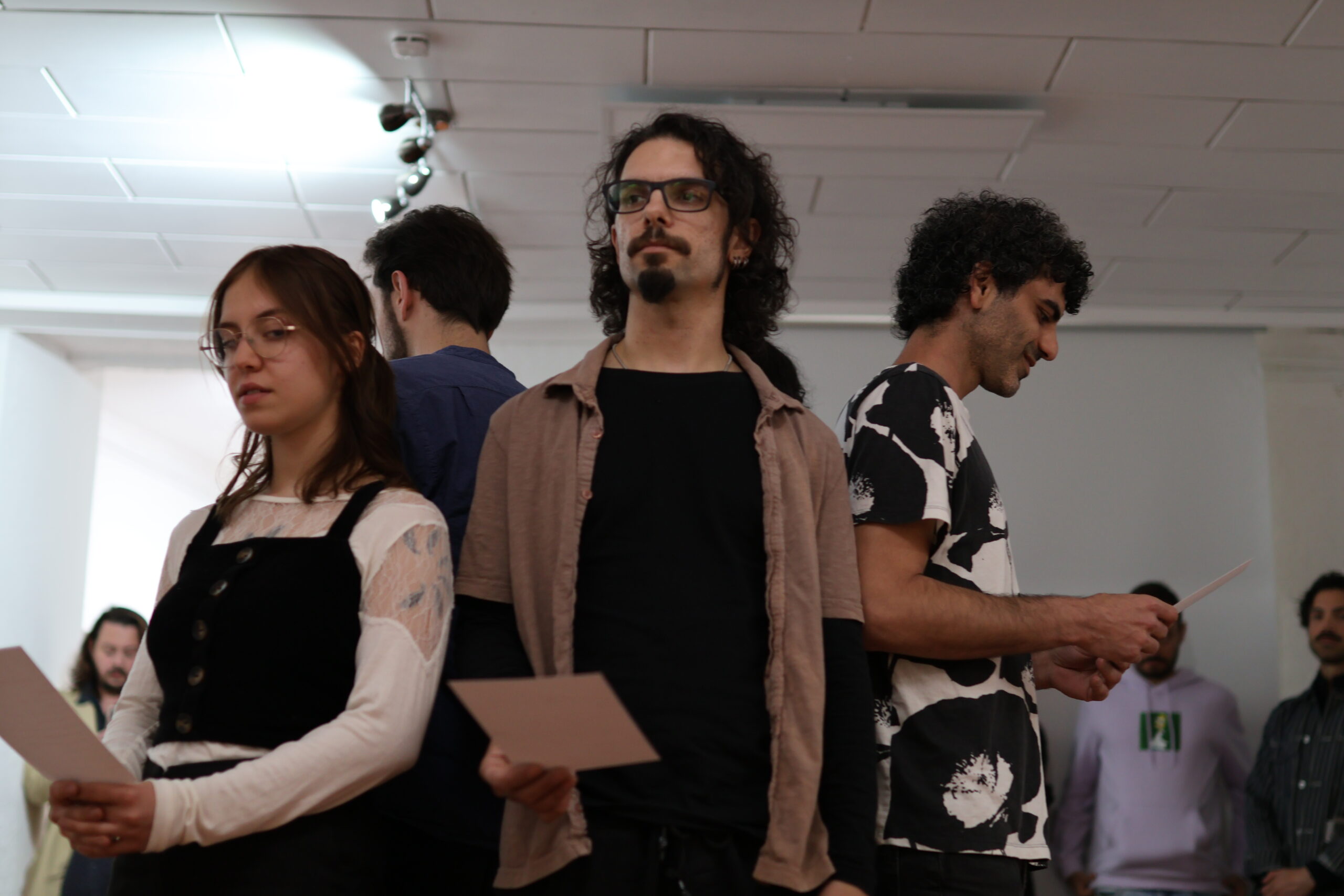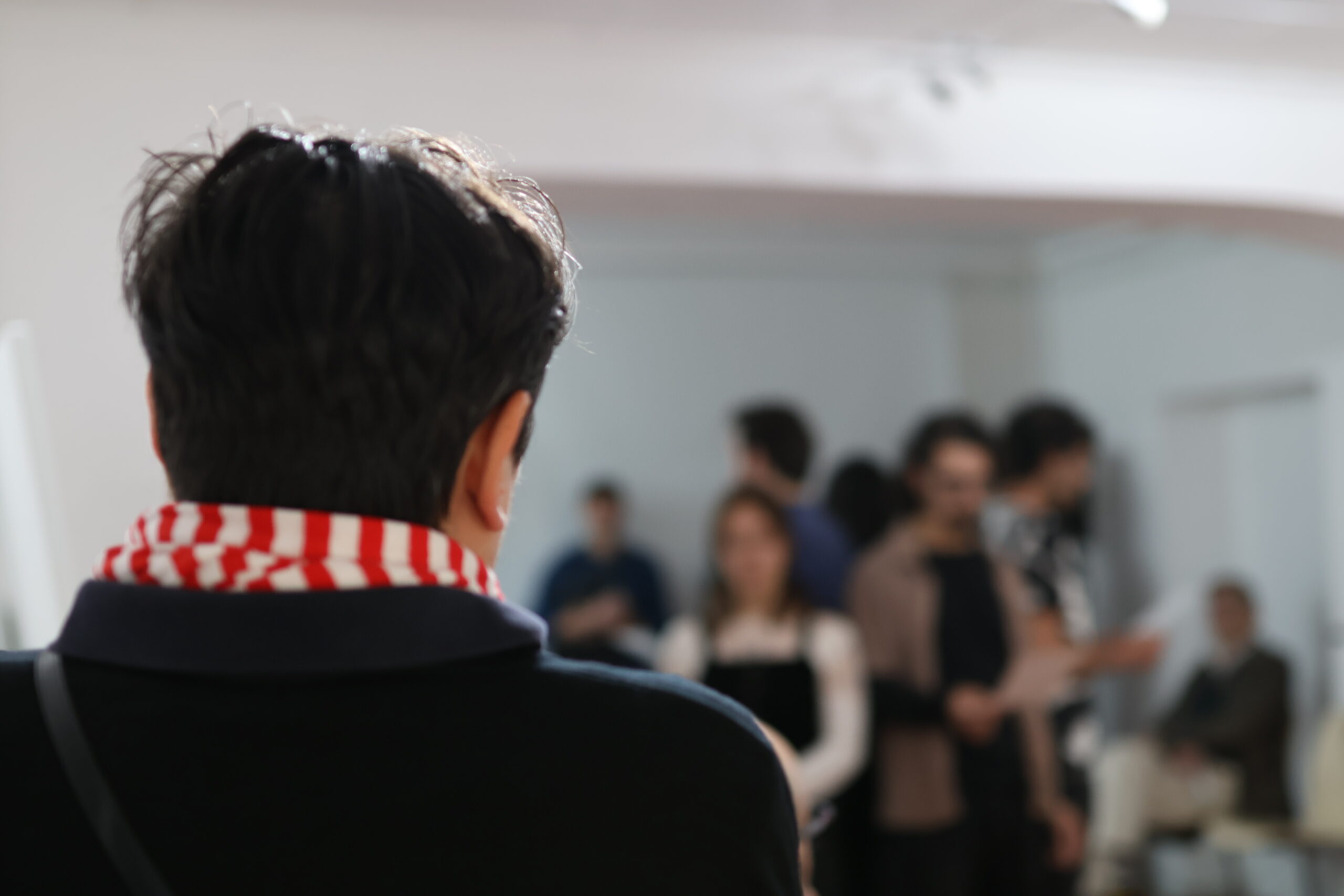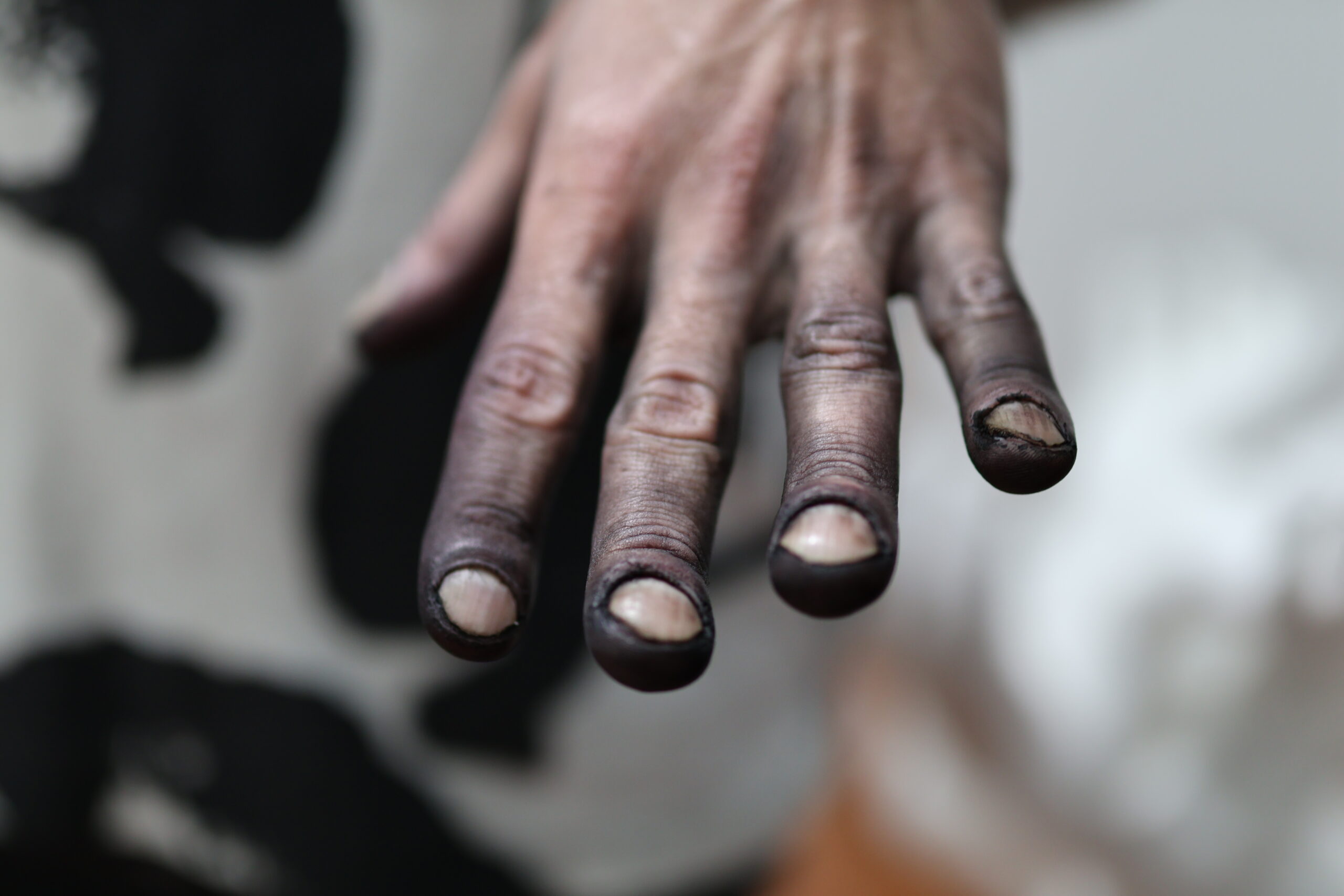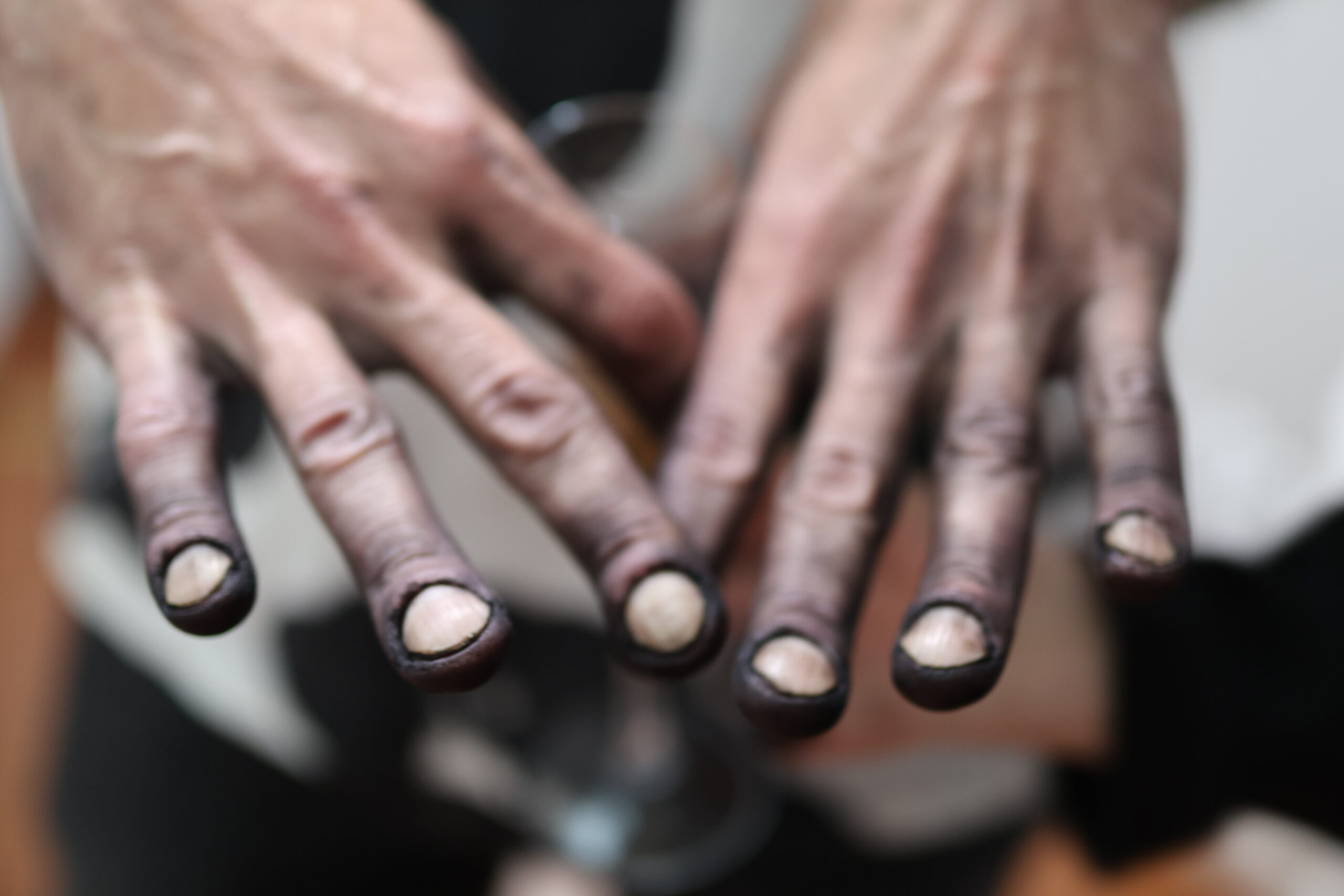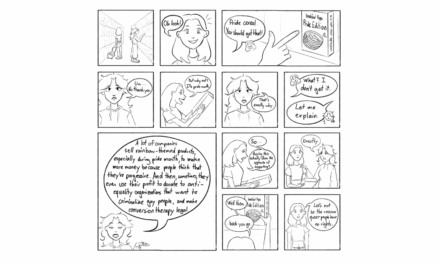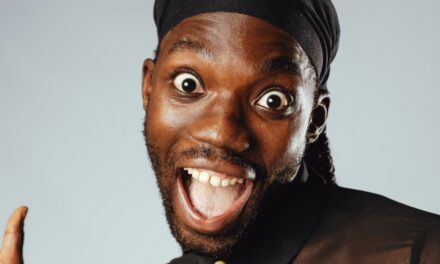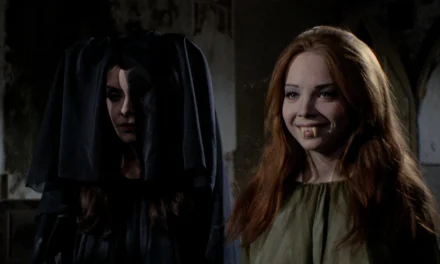
The opening of Sam Hrawy’s exhibition Motions of Silence, held on Friday, May 23, at the Rainbow Center Luxembourg, unfolded in hushed tones. The sound of gasps, scattered words, a rattling chair turned upside-down, scraping faintly against the linoleum floor, all echoed in the eerily quiet vestibule of the queer cultural center, as though trapped in a dance leading either deeper into the dark narrow corridor of the venue or out through the large glass windows where the fading light of the day was folding into evening.
Nearly three dozen attendees gathered tightly inside the modest space, the notably low ceiling of the Rainbow Center further heightened the sense of closure with the theme at hand: silence. Every movement, every sound, every word in the three-act performance by Hrawy and Liminal 4, a collective of collaborating artists, pressed inward, vibrated, reverberated. The moment hung somewhere between performance and suspended breath.
At the time, I was recovering from a knee surgery. My sick leave had been filled with soothing beverages and vertical readings until this evening of grand opening demanded something altogether different: a horizontal mental journey, seemingly gentle but tense, subtle but unsettling, with more questions than answers. In the compressed space of the Rainbow Center, silence was anything but quiet, it became a raucous reckoning, broken only by a couple of brief refreshments and cigarette breaks between the acts.
Motions of Silence is an intimate exhibition, difficult to pin down. It brings together photography, video, sound, sculpture, and draws from Hrawy’s personal experience as a Lebanese expatriate, currently based in the City of Metz, where he recently majored in Fine Arts from the École Supérieure d’Arts de Lorraine (ESAL). The title is itself a paradox: silence often understood as stillness or absence is here set into motion, where Hrawy and fellow artists turn the quiet and subtle sounds, movements and gestures into a tool for survival, a collective strategy to resist erasure, exorcize memory, and reconcile with trauma.
Hrawy and fellow artists turn the quiet and subtle sounds, movements and gestures into a tool for survival, a collective strategy to resist erasure, exorcize memory, and reconcile with trauma.
Questioning is a key metaphor in Sam Hrawy’s exhibition. It informs his approach to navigating identity, memory, and artistic process. In an extended interview I had with Sam, he explained that everything he does begins with a question. His line of questioning is not meant to control meaning or reach definitive answers, but rather as an invitation for the viewer to reflect, relate, and consider multiple perspectives. “I ask the question and I see what the question wants,” he remarked. The choice of the artistic medium is also shaped by the ongoing process of questioning. In the photo collage series entitled “Re-member”, Hrawy examines the idea of erasure and disappearance through photographic fragments of body parts, contorted limbs, which question memory not from a conventional, nostalgic perspective but as incomplete, misunderstood, and distorted fragments. These creatures, as Hrawy calls them, “live in silence inside of us” and seem, at times, almost too hard to look at directly. He began this series during the pandemic, when life came to a standstill and he found himself face to face with his own memory, his own silence.
That particular sense of silence, Hrawy insists, “is double-edged”. It can be comforting, but it can also be challenging. A duality that characterizes every aspect of Motions of Silence, as well as the artist’s personal history.
The viewer cannot fully grasp this exhibition without acknowledging the deep fracture that marks Hrawy’s personal trajectory: his forcible displacement from his native Beirut. In the interview, he described this as “a slap in the face”, which left him disoriented, reeling, and grappling with mourning while striving to reassemble the pieces of his unspoken exile in France, unromanticized and never too clichéd, in a land that knew little about his history or those he left behind. For this exercise, Hrawy turned to plaster in the series of sculptures titled “Ala Qahweh” Over Coffee. Sculptures he refers to as totems that preserve the memory of moments shared, lest they slip away.
This is where silence becomes political. “I look at the world today, and it’s a place where… I wish I could intervene and change a few things”, Hrawy told me as he enthused over the need for healing and transformational change. He spoke with visible distaste of a world that has become increasingly transactional, shaped by the superficial, the performative, and he described his exhibition as an attempt to break the silence and expose the prevailing double standards. In the face of the ongoing atrocities, particularly the one unfolding in Gaza, Hrawy believes that silence, when deployed consciously, becomes a form of resistance. This tension finds shape in the performance titled Je vais être pulvérisé, created by artist Sébastien Faivre-Picon and performed in collaboration with artists Étienne Attal, Sébastien Faivre-Picon, Naomie Fassal, and Marine Lauer, of Laminal 4. Here, gasps and breath become “acts of defiance” against the dominant narrative that gags dissent. Gathered in a circle, their backs against each other, the artists deliver a choreography of interrupted sounds, unfinished words, and fractured movements that reveal their attempt to break their vulnerability.
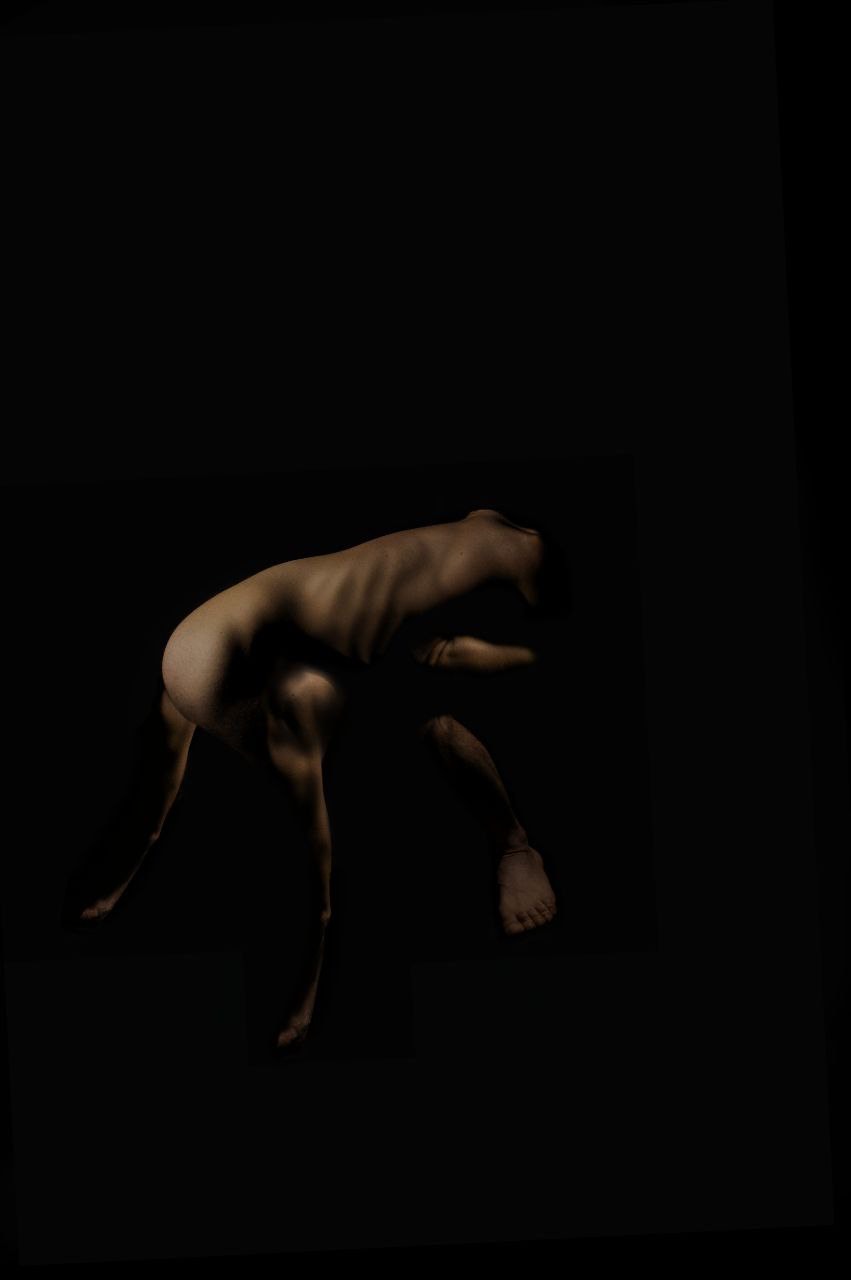
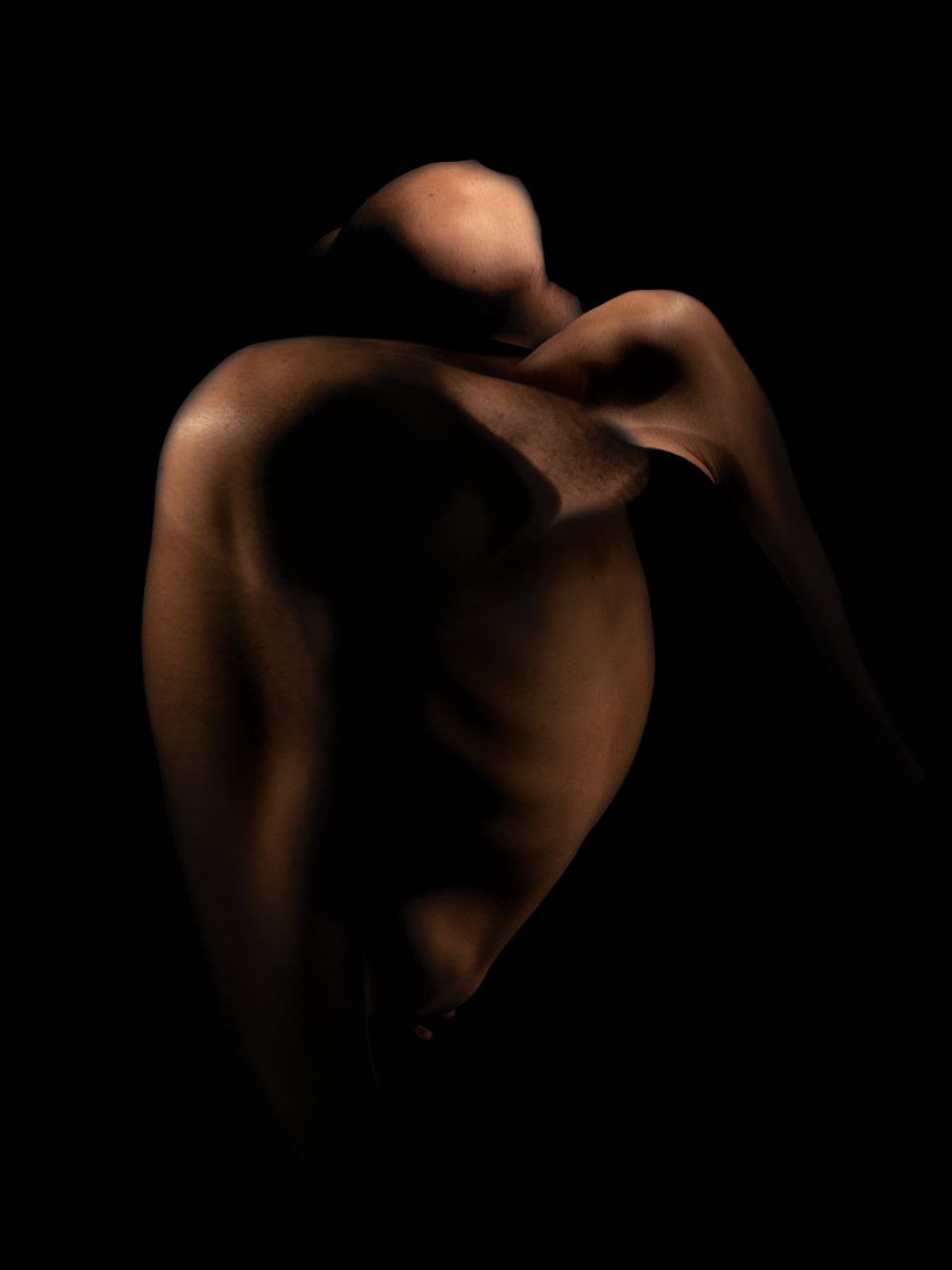
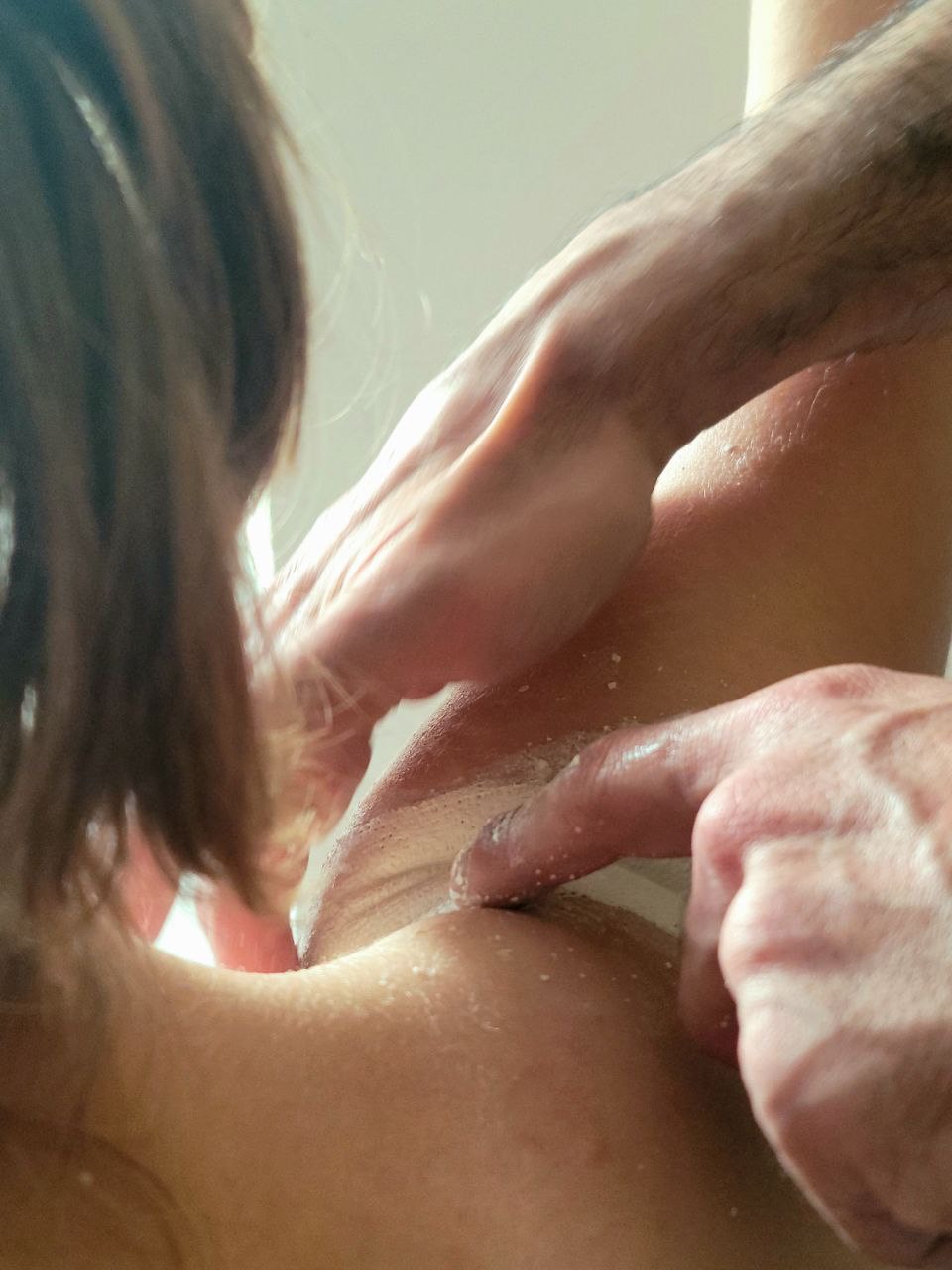
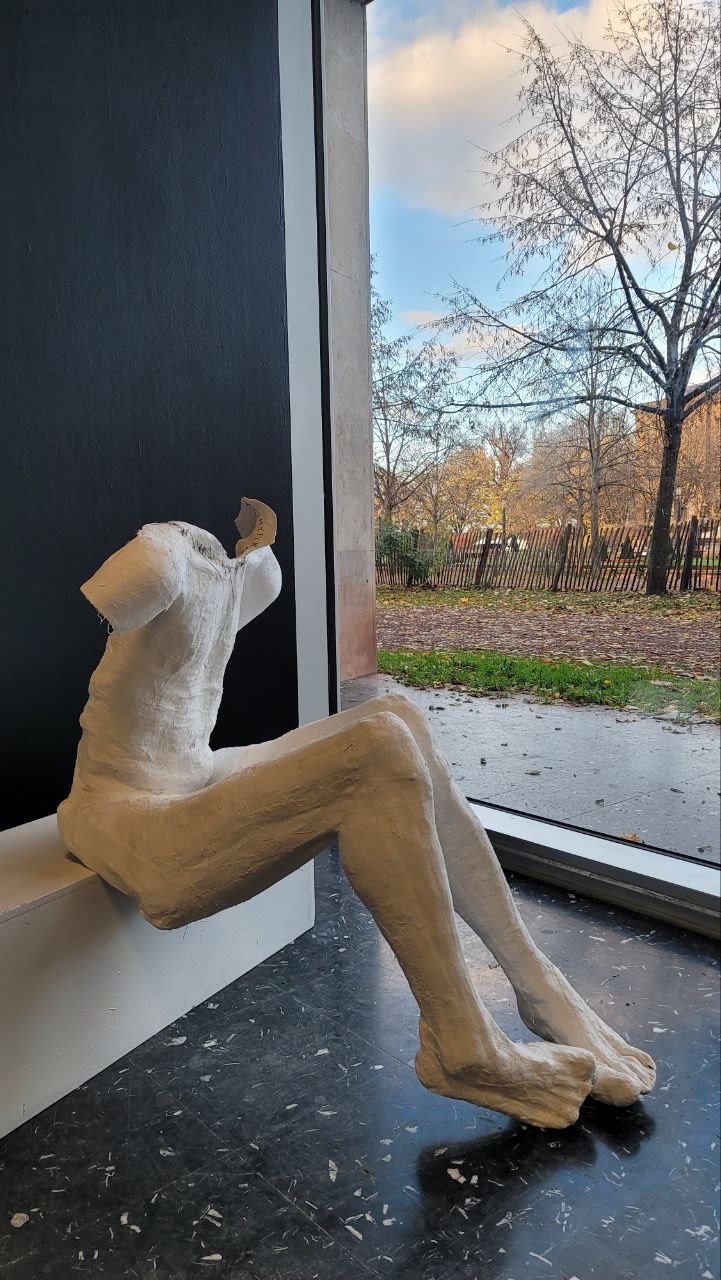
The second act of the exhibition, Marcher, j’ai oublié, brought the evening to a haunting climax. Performed by Ema Ringue Chardin, the five-minute reading unfolded as she rode an upside-down chair, her frail body moving with disquieting determination, stunned the crowd. Her voice, hardly distinguishable as she painstakingly pushed herself forward like a child on a toy bike, was confounding. Her surreal performance, partly vulnerable and partly defiant, and her very presence echoed both fragility and force, embodying the exhibition’s central tension: how one can carry memory without being crushed by it. She was not.
The third and final act, WASSATA_ an Arabic term that loosely translates to “mediation“- consisted of a silent dialogue between Sam Hrawy and Alicia Charrier. Both performers wore minimal skin-toned clothing to emphasize yet again the theme of vulnerability and exposure, as they negotiated their borders, both physical and emotional. They circled each other, ebbed and flowed, their movements ranging from fleeting tender touches to abrupt intentional collisions. Then, with black-ink-soaked hands, they crushed together against a long white triangle canvas, smearing and inscribing it with undecipherable notes of their encounter. The piece raises pressing questions about the volatility and complexity of human connection, put to the test of care and rejection, proximity and withdrawal.
Showing Motions of Silence at the Rainbow Center Luxembourg carries a powerful resonance. For Sam Hrawy, it represents the relief of being able to present his work in a free, open space, far from the heavily policed environment of his past. He reflects on the pressures faced in his homeland and beyond:
“The fact that we are raised to leave the country, the whole political situation in the area—not just in Lebanon, but across the Middle East and the Arab region—has influenced me deeply. When I left Lebanon, it wasn’t because I wanted to; I left to survive.”
The fact that we are raised to leave the country, the whole political situation in the area—not just in Lebanon, but across the Middle East and the Arab region—has influenced me deeply. When I left Lebanon, it wasn’t because I wanted to; I left to survive.
The Rainbow Center’s walls, once home to an escape room, now serve as a site for queer cultural expression, and the irony isn’t lost on Hrawy: a site designed for confinement, and puzzle-solving has become a safe haven for queer diasporic voices and, until July 4, a space for silent introspection, endurance and resilience.
The exhibition ‘Motions of Silence’ by Sam Hrawy is on view at the Rainbow Center Luxembourg from May 23 to July 4, 2025.
Photos from the opening courtesy of the Rosa Lëtzebuerg staff. Additional images provided by Sam Hrawy from his archive.

